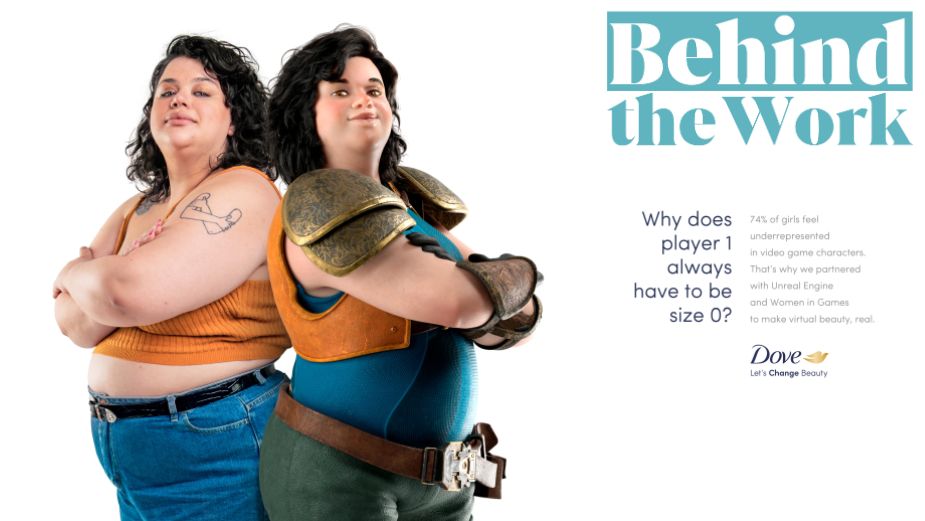
How Dove Turned Real Women into Video Game Heroes

Gaming started off as an exclusively male-oriented hobby, with not much inclusivity on or in front of the screen. As more women started entering the video game industry both as employees and players, we started seeing more female representation in character-based games. But, even then, the trend observed in the latest research from Dove and Women in Games revealed that a whopping 60% of girls and 62% of women feel underrepresented in video games, and over a third of all surveyed girls experience negative effects on their self-esteem due to the lack of diversity and realistic beauty depictions in virtual characters.
This is why creative agency LOLA MullenLowe and hygiene brand Dove took it upon themselves to create the brand’s first animated film, following the story of Cinthia. In her superwoman alien-defeating version, Cinthia is wearing an uncomfortable armour and has all the classic traits of over-objectification and sexualisation that audiences are used to seeing in female video game characters.
However, after defeating her enemy, Cinthia has a moment to herself in her suite - there, we see her change into more comfortable clothes, wipe off her makeup and step into her authentic self. Happier, and more comfortable than ever. And even though it makes perfect sense that somebody would be more comfortable slaying monsters without a metal corset and heels, game developers seem to have missed that memo.
Cinthia is based on a real-life model and her own experiences, but Dove worked with an even wider group of women to create their diverse characters in Unreal Engine and provide game developers with the opportunity to add them to their games, making women and girls’ experiences better in the virtual world.
LBB’s Zoe Antonov spoke to creative directors Jorge Zacher and Kevin Cabuli at LOLA MullenLowe about the importance of the campaign in the continuing fight against female sexualisation in the game industry.
LBB> What was the brief for this campaign and how creatively involved was Dove in the making?
Jorge & Kevin> The brief was centred around the brand's objective - challenging beauty stereotypes. Dove recognised an untapped opportunity in the gaming industry, which they had never explored before. They were actively involved from the beginning, conducting research to understand how girls were affected by these issues. They provided input and guidance throughout the creative process to ensure the campaign aligned with their values and messaging.
LBB> Tell me about the start of the ‘Real Virtual Beauty’ platform and how this campaign continues to build upon it.
Jorge & Kevin> The wider campaign began with a clear goal of celebrating diverse beauty in the gaming industry. Four pieces were created, each telling the story of a different character. In these pieces, the characters questioned the lack of representation while proposing to make virtual beauty real. The campaign also allowed people to download avatars inspired by real women who portray different types of beauty. Beyond the consumer-facing message, the campaign targeted the developers of video games, who have the power to change the situation. This led to the creation of a hero film and various commitments and actions in partnership with the Unreal Engine education team, such as the ‘Real Beauty in Games’ education program to train developers and expand the representation of beauty in video games. The campaign was presented at EGX London and SXSW.
LBB> Why is the platform so important in the industry and especially in gaming spheres?
Jorge & Kevin> Video games have taken on the toxic role that television and movies used to play in perpetuating narrow beauty standards. From a young age, millions of girls are exposed to these beauty stereotypes through video games. Dove believes that beauty should inspire confidence, not anxiety, in all aspects of life, real and virtual. While the gaming industry has made progress in inclusivity, there is a need to accelerate change and challenge the limited definitions of beauty in the virtual world. By partnering with others, Dove aims to make a real impact on the millions of women and girls who spend time playing games.
LBB> Tell me more about Cinthia, whose story you are telling in this campaign. What about the rest of the characters you represent?
Jorge & Kevin> Through interviews and her stories, we explored Cinthia's experiences growing up with overly sexualised beauty representation in the gaming world. She describes growing up there were only two female options to choose from in her favourite video games, and both were extremely over-sexualised characters. So, we made a film that would cover her point of view on the issue. The campaign featured not only Cinthia but also other Real Beauty models such as Sam Almeida Bullock (Brazil), Lily D. Moore (USA), and Coco Anetor-Sokei (Nigeria). All through the same process.
LBB> How can people interact with the characters?
Jorge & Kevin> On the Dove website, game developers could access and download the 3D models for free to integrate them into their platforms. The campaign aimed to demonstrate that inclusive characters could be part of the games millions of girls play today. It was not just about providing the 3D models but also showing that inclusive characters should be part of this growing world.
LBB> What kind of research informed the campaign?
Jorge & Kevin> The campaign was based on a new research study by Dove in partnership with Women in Games. The study revealed that 60% of girls and 62% of women felt underrepresented in video games, and over a third of girls experienced negative effects on their self-esteem due to the lack of diversity in virtual characters.
LBB> How did you work with Unreal Engine on the campaign?
Jorge & Kevin> Real Virtual Beauty involved collaboration with partners in the gaming industry, including Epic Games' Unreal Engine's education team and Women in Games. The campaign included training modules for developers worldwide, aiming to improve the in-game representation of beauty. The goal was to challenge beauty stereotypes, equip young creators and players with tools for self-esteem and body confidence, and leverage the expertise of Dove-funded self-esteem and body confidence scientists at the Centre for Appearance Research.
LBB> How long did the creation of the avatars of all the women take and what were the biggest challenges? What was the animation process like?
Jorge & Kevin> The creation and animation process took approximately five months from start to finish. The campaign collaborated with Passion Pictures under the direction of againstallodds. One of the significant challenges encountered during the production was creating the protagonist, Cinthia. It involved designing two distinct versions of the character—a hyper-sexualised version and a 100% real version. The aim was to maintain Cinthia's recognizable appearance throughout the film as she played a central role in the story. After several revisions, a balance was achieved between the ‘Video Game Cinthia'’ and the ‘Real Cinthia’. including specific visual differentiators like an open helmet and fitted armour.
Being Dove's first animated film and promoting real beauty, it was crucial to maintain the brand identity throughout. The team worked diligently to strike a balance between reality and animation, ensuring the character's movements and skin textures felt as realistic as possible. Interviews with the protagonist and the use of photographic resources were conducted to ensure an authentic portrayal of the story.
LBB> And what was the most fun part of the making?
Jorge & Kevin> The most enjoyable aspect of the entire process was seeing how, step by step, real women became video game heroes. Also, seeing their emotional reactions of as they saw themselves on screen transformed into video game characters.
LBB> How can developers get involved with the campaign, and do you expect the characters to be seen more in the future?
Jorge & Kevin> Developers can download for free all the characters at www.dove.com/real-virtual-beauty.html and incorporate the provided 3D models to create diverse and inclusive characters in their games. By joining forces with them on this campaign, we are hoping that developers can also actively contribute to challenging beauty norms in the gaming industry.
LBB> What do you hope audiences take away from the campaign?
Jorge & Kevin> We hope that audiences recognise that beauty should be a source of confidence rather than anxiety, both in the real world and the virtual one. While the games industry has made significant progress towards inclusivity, there is still a need to accelerate the challenge against narrow beauty standards prevalent in the virtual world. Through our partnerships, Dove aspires to make a tangible impact on the millions of women and girls who spend their free time playing games.
LBB> Any final thoughts?
Jorge & Kevin> We are delighted to have had the opportunity to tell these stories. This campaign allowed Dove to address the themes of inclusion and representation in gaming, delving into this world for the first time ever.













